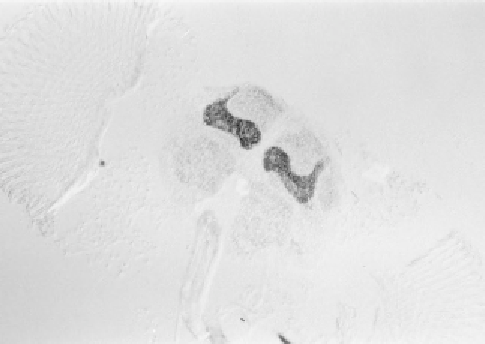Biology Reference
In-Depth Information
Figure 11.1
Photograph of the brain structures known as mushroom bodies in
D. melanogaster
.
The dark areas show the mushroom bodies stained with an antibody to the
dunce
-encoded enzyme.
dunce
+
encodes an enzyme called cyclic AMP phosphodiesterase. This enzyme destroys cyclic AMP,
which is important in learning and memory. (Photograph provided by R. L. Davis.)
foregut activity are found (
Homberg et al. 1989
). The brain is connected to the
subesophageal ganglion via connectives and to the thoracic and abdominal gan-
glia, or ventral nerve cord (
Strausfeld 1976
).
Behavior and development are coordinated in the insect by both nerves and
neuropeptides. Both neurosecretory cells and neurons use
neuropeptides
as mes-
sengers. Many different types of neuropeptides have been identified (
Scharrer
1987, Masler et al. 1993, Raina and Menn 1993, Nassel 2002, Bendena 2010
).
Neuropeptides range in size from three amino-acid residues (thyrotropin-releasing
hormone) to
>
50 (insulin). They are generated from larger precursor proteins, rang-
ing from 90 to 250 amino acids in length. Several neuropeptide genes have been
cloned (
Nassel 1993, 2002; Sato et al. 1993; Tillman et al. 1999; Bendena 2010
).
Neuropeptides are released as cotransmitters and modulate fast transmis-
sion at neuromuscular junctions. A given neuropeptide may occur at several
sites, including central nervous system circuits, peripheral synapses, and at the
peripheral targets (muscles and glands). Neuropeptides regulate behavior by
coordinating temporal and spatial activity of many neuronal circuits. Each of
the circuits controlling behavior uses sets of sensory neurons, interneurons,
and motor neurons. Thus, multiple neural networks share neural elements.
Molecular-genetic analysis is providing rapid progress in understanding
neuropeptide receptors and second-messenger pathways. Research on neuro-
peptides and their receptors indicates that they have roles during embryonic

